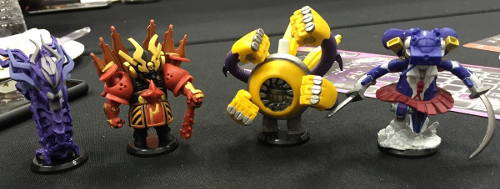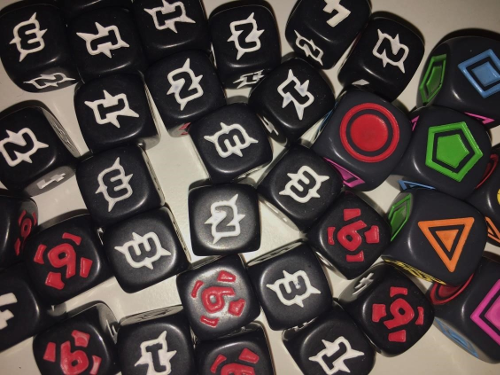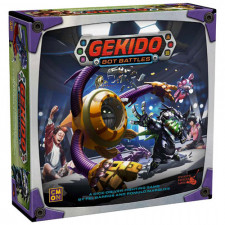Gekido: Bot Battles Review
on May 31, 2017
Here's the pitch for CMON's new Gekido: Bot Battles. It's a dice battle game based on the first ten minutes of Big Hero 6. If you haven't seen that modern Disney classic, it opens with a scene featuring underground bot battles, almost a sort of cock-fighting setup where people bring in home-brew (and super high-tech) remote-controlled robots to duke it out in an arena while onlookers wager. The winners go home with a take from the pot; the losers go home with a broken bot- if enough of it survives to haul back to the garage. It's an unspoken, undocumented inspiration but there's no doubt that this scene is what must have sparked the designers' ideas right on through the designs of the six pre-painted (!) bot miniatures included in the game. And that was enough to sell me on the concept- especially because my kids and I love Big Hero 6.

Probably the best advertisement for the game that you'll see.
Mechanically, there isn't much particularly novel about Gekido- it's a pretty typical dice-roller wherein you get a couple of rolls to make certain sets and over the course of the game you get upgrades and other advantages that make it easier to fudge the rolls in your favor. Per the setting, you are "programming" attacks for your bot each turn, and you get three rolls to make poker hands of symbols. The harder sets, such as a full house or five-of-a-kind, yield more damage but there is also a risk if you decide to push your luck. Fail to meet the program you've locked in after the first roll and your bot malfunctions, taking damage. But if you make the program work, you'll inflict damage on your targeted opponent.
Damage comes off from six D6s set up as "structure points", and when you completely lose a die, it causes that dice to generally move over to an upgrade or power slot on your bot card. According to the rulebook, the bots start to fight harder and more fiercely as they take damage. But it is really kind of a balancing mechanic that doesn't make much logical sense and it in fact sort of inverts the tension curve over the course of the game. Upgrades and powers might increase damage or armor, or impart dice-manipulating effects such as flipping them over, extra re-rolls, and so forth. There are also special cards that can be earned through completing the lowest risk, lowest damage two pairs/three-of-a-kind sets or by standing in the middle of the arena, and these do similar things. There are also some fun effects that occur when your bot is destroyed- such as letting you make a parting attack or allowing you to remain at one structure point for a possible Hail Mary play.
There is also a minor spatial element at work. The arena consists of nine tiles, and on each turn you must move adjacent to an eligible target- this is determined by a set of target lock tokens, which also ensure that you attack each other player once until they reset. These spaces also impart bonuses or penalties for attacks and defense or provide other dice manipulating effects. When you complete an attack, you can also push a bot off the space that they are on. This all sounds like it would add an interesting element to the gameplay, but it really kind of doesn't. With only nine spaces on the board and all of them relatively balanced in terms of advantage and disadvantage, it feels almost like an irrelevant element.
But the biggest issue I have with Gekido is one that I think is common with most modern dice games. There is too much design work invested in controlling the luck of dice to circumvent the inevitable sentiment that there is too much of a "luck factor" in the game. There are so many ways to control the results- and this is after three basic rolls- that over the course of the game, the sense of drama and risk becomes greatly reduced. At first, you might think twice about trying to risk the higher value rolls. But by the end of the game, you will likely have a couple of powers and cards- coupled with the effects of some of the arena space- that will most of the time complete one of the higher programs.

It's really a dice game.
The gold standard of dice games, as far as I'm concerned, remains Sid Sackson's Can't Stop. It may not have an adorable cat robot figure, but it has a very strong sense of escalating risk and reward. The game constantly challenges you to take chances, but it also rewards a degree of caution based on simple probability calculations. It doesn't rely on special powers or changing results to generate an exciting, dramatic experience. All of the extra rolls, dice-turning and cards that grant you set results saps a lot of the delicious anticipation and excitement of dice rolling. Which isn't to say that Gekido isn't exciting and can't be dramatic- just about 20 minutes prior to writing this review, I bombed the very last program roll of a game in which my son came back from looming defeat to just pulverize me after I clobbered my daughter and thought for sure I had it in the bag..
I like this game and I love the cool miniatures, and it is a fun family game overall in the vein of King of Tokyo. My kids LOVE it, which reserves it a spot in our collection. With that said, I find myself wishing that it were actually pitched just a little younger than it is because I think it's a much better kid's game than it is an adult hobby game. Some aspects of it are a little tricky for younger kids to grasp, and the rulebook-proposed two player "duel" game that eliminates those trickier elements isn't really worth playing. In fact, I think the game really demands four players to produce the most consistently interesting, fun and exciting experience.

 Customer Support
Customer Support  Subscribe
Subscribe 




 Account
Account  Wishlist
Wishlist 

